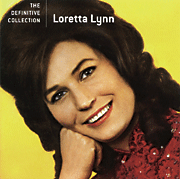

In her 1976 memoir, Coal Miner’s Daughter (written with journalist George Vecsey), Loretta Lynn dispels the myth that all of her song lyrics come from her own diary. “Honky Tonk Girl” was inspired by a young woman Lynn saw crying into her beer in a bar. “You Ain’t Woman Enough (To Take My Man)” describes the domestic strife of one of her fans. But if there’s one song that sets Lynn’s personal memories to music, it’s her affectionate, understated appreciation of her childhood, “Coal Miner’s Daughter.”
Like the song says, Lynn was born into a loving family in a shack in Butcher Holler, near the coal-mining town of Van Lear, Ky. Born in 1935, she was the second of eight siblings, and her family’s struggle for survival was unfortunately commonplace. Her father Melvin Webb’s health suffered cruelly from years of hard labor and breathing coal dust. Her mother, Clara, bore all but one of her children at home because the family didn’t have the resources for a hospital stay. Lynn’s first memories of singing for an “audience” are of shouting hymns out to the hills as she rocked one of her younger brothers or sisters on their front porch.
“That was my main job,” she writes in her memoir. “I’d swing and rock them babies and sing at the top of my voice.”
Lynn met her husband, 19-year-old Oliver “Doolittle” Vanetta Lynn, at a “pie social” when she was 13 years old, and she was married, against her parents’ wishes, before she turned 14. Lynn was pregnant with her first child when Doolittle was offered a job on a ranch in Washington state, and the Lynns began to raise their growing family in the Northwest.
Several years after their move to Washington, Doolittle surprised his wife — by then a mother of four — with a guitar and told her to learn how to play it.
“Doo said I had a good voice, and he wanted me to sing. What did I think?” Lynn recalls in Coal Miner’s Daughter. “Well, I was surprised. Stunned, you could say. I didn’t know Doolittle thought that much about my singing. I was proud to be noticed, to tell you the truth, so I went right to work on it. When the kids were in school or asleep at night, I’d sit in my front room, learning how to play the guitar better. I never took no lessons or nothing — I just played. After a while, I got where I could play a pretty good tune on it. First I was singing Kitty Wells’ songs on it, but after a while I started making up my own.”
Doolittle proceeded to talk his shy young wife’s way into club dates. Her first single, “Honky Tonk Girl,” was bankrolled by a wealthy Vancouver widower named Norm Burley; he saw Lynn perform “My Shoes Keep Walking Back to You” on a TV talent-show broadcast from Tacoma, Wash., and simply decided he wanted to help her career. Burley released the single on a one-shot label he called Zero Records. He even pitched in for a radio-promotion tour; the Lynns traveled from Washington to Nashville, stopping at every country radio station along the way to encourage disc jockeys to play the single. By the time Lynn arrived in Nashville, she had a hit single and a little more confidence.
Lynn writes that she talked her way into her first appearance on the Grand Ole Opry radio program by “pestering” the manager, Ott Devine. Not long after that, they decided that she could use some help to make more headway in Music City, so they turned to the Wilburn Brothers, popular country artists at the time who also ran a talent agency. They signed Lynn and brought her into their own studio, Sure-Fire, to record a new song they could shop to labels. That demo song was called “Fool Number One.”
“They figured I might as well start at the top, so they took the ‘demo’ record to Owen Bradley at Decca Records. Owen Bradley is one of the biggest men in the business,” Lynn wrote in her 1976 memoir. “He talks like an easygoing country man, but he’s been responsible for more country music hits than anybody.”
When Lynn and the Wilburns first approached Bradley, the now-legendary producer was still recording all of his productions in the 3-track Quonset Hut studio, where he and engineer Selby Coffeen had captured Patsy Cline’s masterpieces, such as “I Fall to Pieces” and “Crazy.” He owned that studio with his brother, Harold Bradley, who is now widely considered the most-recorded guitarist of all time, with dozens of credits including Cline, Ernest Tubb, Ray Price and Elvis Presley, as well as Lynn.
“Owen was looking for a song for Brenda Lee,” Harold Bradley explains, “The Wilburns were pitching him Loretta’s song, and he liked the song, but he wanted it for Brenda Lee. But they said, ‘You can’t have the song without the artist.’ So they reached a compromise.”
Owen Bradley signed Lynn to a six-month contract with the agreement that Lee would record “Fool Number One” but Decca Records would put out a different record for Lynn if she had another song. She had plenty, and she and Bradley soon had a string of hits with tracks such as “Blue Kentucky Girl,” “You Ain’t Woman Enough (To Take My Man)” and “Fist City.” Lynn and Owen Bradley also developed a very warm working relationship.
“I always felt like Owen was a father to me,” Lynn writes. “He could see I was just a scared little country girl, and he made me relax. I remember one time, after we signed, we didn’t have any money. I started crying in his office, and he gave me $1,000 out of his pocket, not from the company, to pay my rent and the back bills. The next year, we were making some money and we paid Owen back. But I ain’t never forgotten that man helping me like he did.”

“Owen was very wise in capturing her talent,” Harold Bradley says today. “Whatever she was putting out, he accepted it as having charm and sincerity. Singing those songs was her great passion because she believed them and lived many of them.”
Not long before Lynn wrote and recorded “Coal Miner’s Daughter,” Owen Bradley sold his Quonset Hut studio to CBS/Columbia. For a while, he continued recording there, but then Columbia decided to stop selling studio time to non-Columbia artists.
“Owen called me, and said, ‘They shut me out of my own studio. I can’t record there anymore,’” says Jim Williamson, the engineer who recorded most of the Lynn tracks that Bradley produced. “And I said, ‘Well, Owen you gotta remember, you sold the sucker!’ And he said, ‘Well, why don’t you come over here and talk about coming to work for me.’ And that really hit me between the eyes because Owen Bradley was the father of the music business in most of our minds. To work for him, you were at the pinnacle of your career.
“So I left CBS and went to work for Decca,” Williamson continues. “He told me one of the things he wanted me to do was design and build a recording studio at South Street and 16th. I went down with some equipment that I’d rented and determined that particular location, due to the WLAC-AM radio tower, was just loaded with RF. We would have had to build a big screen room to make it work, and then we would still have problems. I told him that from my point of view, that as much as I would like to design and build Decca’s recording studio in Nashville, we should go somewhere else.
“He said, ‘I have my studio out in Mt. Juliet, but I can’t record there because it would be a conflict of interest. I said, ‘I don’t understand that. Decca needs a recording studio to record their acts. Why don’t you have Decca pay the studio a fair fee per hour and rent the studio to record Decca artists?’ And he said, ‘You think that would be all right?’ And I said, ‘I know it would be all right.’ Owen was probably the epitome of an honest businessman.”
So Owen Bradley, Williamson and Decca’s A-list musicians moved their main recording operations out to Bradley’s Barn in Mt. Juliet. Williamson remembers well the gear they had out in that studio, largely because it provided a constant challenge: The console was a 4-channel, 12-input P.A. board from Altec-Lansing.
“It had an outrigger, which was an Ampex MX10, 4-mic in, 2-channel out mixer that was mounted in a side rack,” Williamson says. “Between recording and playback, you had to break the whole cotton-picking thing down and repatch it for playback, which, of course, lost your levels, so you had to set levels every time you had a playback. After Decca began using the studio exclusively for its recordings, Owen authorized upgrades that helped tremendously. The Ampex mixer had been added to facilitate driving an 8-track recorder. A 16-track recorder was added some time just before, or after, the studio moved.”
The recording sessions that included “Coal Miner’s Daughter” took place in October of 1969. Williamson says he can still see the musicians out in the room in his mind’s eye: “You want me to draw you a mental picture? Buddy Harman’s drums were center-stage in an open booth that offered minimum isolation, so I had to use the omni position on many of the mics and close proximity to gain more control.
“So with the drum booth at the center of a clock, 12 o’clock was Hargus ‘Pig’ Robbins on piano with Bob Moore in close proximity on bass; 1 to 2 o’clock would be rhythm guitars; 3 and 4 o’clock would be electric and steel guitars; Loretta would be singing at about 5 o’clock; and The Jordanaires singing background at 6 or 7 o’clock.”
The guitarists on “Coal Miner’s Daughter” were members of Owen Bradley’s usual A-team: Harold Bradley, Grady Martin and Ray Edenton. Williamson recalls using a Neumann U67 mic for electric and steel guitars, and a Schoeps on rhythm. He says the lead vocal mic would have been a U47 or 67.
While most of the song was cut live, Harold Bradley believes that Bobby Thompson’s banjo work was overdubbed. The only overdub Williamson remembers doing was one extra word: “Loretta came into the control room and we made a playback,” Williamson says, “and she said, ‘Aw, shucks, I wanted to say, “yeah” going into that last chorus. I wanted to say, “Yeah, I’m proud to be a coal miner’s daughter,” and I left it out.’ And I said, ‘Well, why don’t you jump out there and give me a “yeah”?’ And she said, ‘You can do that?’ And I said, ‘Just listen along, and when it gets to that point, you just go ahead and bellow out “yeah” and we’ll have it.’ So I chose a track that was open, and I just walked along a few bars before and she said ‘yeah,’ and it was over.”
It’s perhaps a little-known fact that Lynn’s original composition had nine verses. “My brother cut it down to the six he thought were more relevant,” Harold Bradley says, “because she’d written a short book there.”
“One verse was about mommy papering the walls with magazines, right above my head with pictures of movie stars and such,” Lynn writes. “Another was how the creek would rise every time it rained, and daddy would have to cut logs across so we could get downhill. The third was about hog-killing day in December so we’d have fresh meat for Christmas.”
That “short book” stayed in the can for almost a year until Decca released it as a single in 1970; Lynn says that for a long time, she “didn’t believe anybody would buy a song just about me.” But the song clearly resonated with a broad audience; it rose to Number One on Billboard’s Country Singles chart, contributed to Lynn winning the Country Music Association’s Entertainer of the Year Award in ’72 and, of course, became the basis of Lynn’s autobiography and hugely successful Coal Miner’s Daughter film starring Sissy Spacek.
Williamson continued doing studio work for several more years before changing to a career in real estate, but he looks back fondly on his days working for Owen Bradley: “It was a tremendous treat, and I just learned googles from the guy; more than you could ever think. And we were buddies right up to the day he died.”
Owen Bradley passed away in 1998. His brother Harold, now VP of the American Federation of Musicians, is quick to point out that he’s still making musical memories, but he knows that those days at the Quonset Hut and in Bradley’s Barn, working side-by-side with his brother, were some of the best.
“One thing about Loretta,” Harold Bradley says, “when you walked in the studio, you were going to get a hug, and when you left, you were going to get a hug. We all became like a family. The business part was secondary to the personal part of going in and meeting an old friend and having a party and making a few records.”

PLAY: Must Play
General thoughts about Nashville recording scene
PLAY: Must Play
…on Loretta Lynn
PLAY: Must Play
…on signing Loretta Lynn
PLAY: Must Play
Coal Miner’s Daughter







